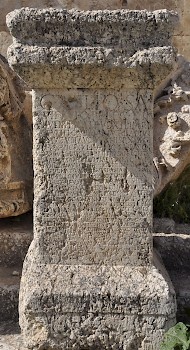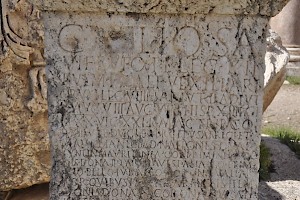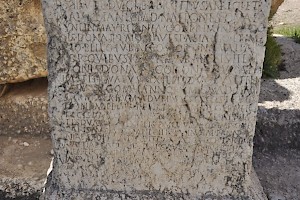G. Velius Rufus
Gaius Velius Rufus (before 40 - after 96): Roman officer and war hero from the Flavian age.
Gaius Velius Rufus is best known from an inscription that was discovered at the Great Court in front of the temple of Jupiter Optimus Maximus Heliopolitanus at Baalbek in eastern Lebanon. The inscription, known as AE 1903, 368, allows us to reconstruct a remarkable military career.
| C(aio) Velio Sal- vi f(ilio) Rufo p(rimo)p(ilo) leg(ionis) XII Fulm(inatae) praef(ecto) vexillari- orum leg(ionum) VIIII I: Adiut(ricis), II Adiut(ricis), II Aug(ustae), VIII Aug(ustae), VIIII Hisp(anae). XIIII Ge- m(inae), XX Vic(tricis), XXI Rapac(is), trib(uno) co- h(ortis) XIII urb(anae), duci exercitus Africi et Mauretanici ad nationes quae sunt in Mauretania comprimendas, do- nis donato ab Imp(eratore) Vespasiano et Imp(eratore) Tito bello Iudaico corona vallar(i), torquibus, phaleris, armillis, item donis donato corona murali hastis duabus, vexillis duobus et bel- lo Marcomannorum Quadorum Sarmatarum adversus quos expedi- tionem fecit per regnum Decebali regis Dacorum corona murali, has- tis duabus, vexillis duobus; proc(uratori) Imp(eratoris) Cae- saris Aug(usti) Germanici provinciae Panno- niae et Dalmatiae, item proc(uratori) provinciae Raetiae ius gladi. Hic missus in Parthiam Epipha- nem et Callinicum, regis Antiochi filios, ad Imp(eratorem) Vespasianum cum ampla manu tribu- tariorum reduxit. M(arcus) Alfius M(arci) f(ilius) Fabia O- lympiacus aquilife[r] vet(eranus) leg(ionis) XV Apollinar(is). |
Which can be rendered as:
To Gaius Velius Rufus, son of Salvius, who served as
|

It's quite a list, and it offers a lot of information about an extremely interesting career. In the first place, Gaius Velius Rufus' father was called Salvius, an Oscan name, which suggests that his family was from Central Italy. About Velius' first offices and his lower military ranks, the inscription tells us nothing, but it does inform us about several important stages in his military career, and from these, we can deduce something about the unmentioned years.
The first of the four important stages must have been the Jewish War of 66-70, after which Velius received several rewards: "a wall crown, torques, phalerae, and armillae". These decorations were usually given to centurios and inform us about his rank in 70. The wall crown proves that during one of the sieges, he was the first to climb the ramparts of a city.
During the next years, he remained in the army as centurio, and in 73, he was sent out on a special diplomatic mission. In the previous year, Commagene, a vasal kingdom along the Upper Euphrates, had been annexed to the Roman Empire. Its last king, Antiochus IV Epiphanes, had two sons, Epiphanes and Callinicus, who fled to the Parthians. Velius conducted the negotiations with the Parthian king Vologases I, and obtained the extradition of the two princes. This incident is also recorded by the Jewish historian Flavius Josephus.note

After this, Velius served as primus pilus (the highest ranking centurio) in XII Fulminata, and immediately after, he was made commander (tribunus) of the Thirteenth Urban Cohort, which was based in Carthage. In c.85-87, he was the "leader of the army of Africans and Mauritanians that suppressed the nations that live in Mauretania", and received his second set of decorations: another mural crown, two spears, and two banners.
This was his first independent command, and the emperor, Domitian, must have known about him, and must have asked him to come to the north, to the Danube, where a large war had started against the Dacian king Decebalus. After a couple of setbacks, the Romans defeated their main enemy, and an expedition was sent out across Dacia, to the Sarmati, Quadi, and Marcomanni beyond the Dacians. Velius was the commander of a vexillatio of nine legions, which means that he was in charge of a force made up of subunits from other legions.

Here is a complication, because the inscription mentions only eight units, all from Britain and Germania Superior.
- There's one legion missing, XI Claudia.
- The numeral VIIII is wrong and there were only eight legions involved.
It is common to accept the first option. After this campaign, he received his third set of decorations: his third mural crown, and his second set of spears and banners.
Between 90 and 93, Velius must have acted as Domitian's procurator in the provinces of Pannonia and Dalmatia. This means that by now, Velius no longer was a normal Roman citizen, but belonged to the order of knights. It is beyond doubt that the poet Martial refers to Velius in Epigram 9.31. Finally, Domitian made him procurator of Raetia, where his residence must have been Augsburg.
Domitian was assassinated in 96, and it may be no coincidence that we know of no promotion of Velius during the reigns of Nerva or Trajan: Velius probably was too much part of Domitian's court to be acceptable to the new regime. The year of his death is unrecorded, but there's an intriguing clue, because Marcus Aurelius, who wants to show that worldly fame is just a dream, mentions a Velius Rufus in a list of people who had achieved great fame and retired to their country estates.note This may well be a reference to the hero of the Jewish, African, and northern wars, although it may also refer to one of his descendants.
Among the descendants of Gaius Velius Rufus was Decimus Velius Rufus Julianus, consul in 178, and executed in 183 by the emperor Commodus.note
Literature
- D.B. Campbell, "Gaius Velius Rufus", in: id., The Rise of Imperial Rome (AD 14 - 193) (2013) 78-80
- D. Kennedy, "C. Velius Rufus", in: Britannia 14 (1983) 183-196
- K. Strobel, "Zur Rekonstruktion der Laufbahn des C. Velius Rufus", in: Zeitschrift für Papyrologie und Epigraphik 64 (1986) 265-286